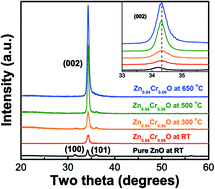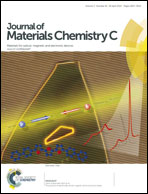Tunable ferromagnetic behavior in Cr doped ZnO nanorod arrays through defect engineering
Abstract
Zn vacancy (VZn) effects on the microstructure and ferromagnetism (FM) of Zn0.94Cr0.06O nanorod arrays have been investigated using a combination of experimental measurements and first-principles calculations. The well-aligned Zn0.94Cr0.06O nanorod arrays were synthesized by radio frequency magnetron sputtering deposition at different substrate temperatures. The Cr K-edge X-ray absorption near-edge structure (XANES) and X-ray photoelectron spectroscopy results revealed that the Cr3+ ions were located at the substitutional Zn sites. Moreover, the O K-edge XANES analysis and resonance Raman scattering indicated the existence of numerous VZn. The stable FM observed at room temperature was an intrinsic property of Zn0.94Cr0.06O nanorod arrays. With increasing substrate temperature, improved crystallinity along with the increase in VZn was observed in Zn0.94Cr0.06O nanorod arrays, and an enhancement of magnetic moment in the samples came forth. First-principles calculations revealed that the enhanced magnetism mainly comes from the unsaturated 2p orbitals of the surrounding O atoms, which is caused by the presence of the Zn vacancy. This research represents a novel promising route for tuning the magnetic behavior of nano-dilute magnetic semiconductor systems via VZn changes.


 Please wait while we load your content...
Please wait while we load your content...